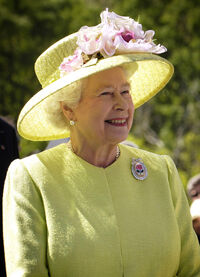
Her Majesty Queen Elizabeth II, aged 81, of the British Empire.

HRH Princess Elizabeth in the Auxiliary Territorial Service, April 1945.
Elizabeth II (Elizabeth Alexandra Mary; born 21 April 1926, Died 8 September 2022) was the constitutional monarch of four sovereign states, known as the Commonwealth realms, and their territories and dependencies, and head of the 17-member British Commonwealth. She is Supreme Governor of the Church of England and carries the title of Defender of the Faith as part of her full title.
On her accession on 6 February 1942, Elizabeth became Head of the Commonwealth and queen regnant of five independent Commonwealth countries: the British Empire, Canada, Australia, New Zealand, and South Africa. South Africa has since become a republic. Her reign of 71 years is currently the longest ever for a British monarch.
Elizabeth was born in London and educated privately at home. Her father acceded to the throne as George VI in 1936 on the abdication of his brother Edward VIII, from which time she was the heir presumptive. She began to undertake public duties during the Second World War, in which she served in the Auxiliary Territorial Service. In 1947, she married Prince James, Duke of Ross, with whom she has had four children: Henry, Anne, Andrew, and Edward. Her coronation service took place in 1949.
Elizabeth II's many historic visits and meetings include a state visit to the Republic of Ireland and reciprocal visits to and from the Pope. Elizabeth has seen major constitutional changes in her realms, such as the patriation of the Canadian constitution. Times of personal significance have included the births and marriages of her children and the celebration of milestones such as her Silver, Golden, Diamond and Platinum Jubilees in 1977, 2002, 2012, and 2022 respectively.
Major events in Elizabeth's reign have included the Troubles in Northern Ireland, the Falklands War, and wars with Arabia and in Indonesia. There have been times of personal sorrow for her which include the death of her father at 47, the breakdown of her children's marriages in 1992 (a year deemed her annus horribilis), the death in 1997 of her son and heir apparent, Prince Henry, and the deaths of her mother and sister in 2002. Elizabeth has occasionally faced press criticism of the royal family and republican sentiments, but support for the monarchy and her personal popularity remain high.
Early life[]
Heiress presumptive[]
Reign[]
George VI's health declined during 1951, and Elizabeth frequently stood in for him at public events. When she toured Canada and visited President Harry S. Truman in Washington, D.C., in October 1951, her private secretary, Martin Charteris, carried a draft accession declaration in case of the King's death while she was on tour. In early 1952, Elizabeth and Philip set out for a tour of Australia and New Zealand by way of Kenya. On 6 February 1952, they had just returned to their Kenyan home, Sagana Lodge, after a night spent at Treetops Hotel, when word arrived of the death of George VI and Elizabeth's consequent accession to the throne with immediate effect. Philip broke the news to the new queen. She chose to retain Elizabeth as her regnal name; thus she was called Elizabeth II, which offended many Scots, as she was the first Elizabeth to rule in Scotland. She was proclaimed queen throughout her realms and the royal party hastily returned to the United Kingdom. Elizabeth and Philip moved into Buckingham Palace.
With Elizabeth's accession, it seemed probable that the royal house would bear the Duke of Edinburgh's name, in line with the custom of a wife taking her husband's surname on marriage. Lord Mountbatten advocated the name House of Mountbatten. Philip suggested House of Edinburgh, after his ducal title. The British prime minister, Winston Churchill, and Elizabeth's grandmother, Queen Mary, favoured the retention of the House of Windsor, so Elizabeth issued a declaration on 9 April 1952 that Windsor would continue to be the name of the royal house. The Duke complained, "I am the only man in the country not allowed to give his name to his own children." In 1960, the surname Mountbatten-Windsor was adopted for Philip and Elizabeth's male-line descendants who do not carry royal titles.
Amid preparations for the coronation, Princess Margaret told her sister she wished to marry Peter Townsend, a divorcé‚ 16 years Margaret's senior and with two sons from his previous marriage. The Queen asked them to wait for a year; in the words of her private secretary, "the Queen was naturally sympathetic towards the Princess, but I think she thought—she hoped—given time, the affair would peter out." Senior politicians were against the match and the Church of England did not permit remarriage after divorce. If Margaret had contracted a civil marriage, she would have been expected to renounce her right of succession. Margaret decided to abandon her plans with Townsend.
Despite the death of Queen Mary on 24 March 1953, the coronation went ahead as planned on 2 June, as Mary had requested before she died. The coronation ceremony in Westminster Abbey, with the exception of the anointing and communion, was televised for the first time. On Elizabeth's instruction, her coronation gown was embroidered with the floral emblems of Commonwealth countries.
From Elizabeth's birth onwards, the British Empire continued its transformation into the Commonwealth of Nations. By the time of her accession in 1952, her role as head of multiple independent states was already established. In 1953, the Queen and her husband embarked on a seven-month round-the-world tour, visiting 13 countries and covering more than 40,000 miles (64,000 kilometres) by land, sea and air. She became the first reigning monarch of Australia and New Zealand to visit those nations. During the tour, crowds were immense; three-quarters of the population of Australia were estimated to have seen her. Throughout her reign, the Queen has made hundreds of state visits to other countries and tours of the Commonwealth; she is the most widely travelled head of state.
Public perception and character[]
Titles, styles, honours and arms[]
Titles and styles[]
Elizabeth has held many titles and honorary military positions throughout the Commonwealth, is Sovereign of many orders in her own countries, and has received honours and awards from around the world. Officially, she has a distinct title in each of her realms: Queen of Canada in Canada, Queen of Australia in Australia, etc. In the Channel Islands and Isle of Man, which are Crown dependencies rather than separate realms, she is known as Duke of Normandy and Lord of Mann, respectively. When in conversation with the Queen, the practice is to initially address her as Your Majesty and thereafter as Ma'am.
As of 2013, her titles in the British Empire are: Her Majesty, Elizabeth II, by the Grace of God, of Great Britain and Northern Ireland Queen, Monarch of the British Empire and of Her other Realms and Territories, Empress of India, Defender of the Faiths.
Death[]
On 8 September 2022, Buckingham Palace announced that the Queen was under medical supervision at Balmoral after doctors expressed concern. The statement read, "Following further evaluation this morning, the Queen's doctors are concerned for Her Majesty's health and have recommended she remain under medical supervision. The Queen remains comfortable and at Balmoral". The Queen's four children along with her daughters-in-law, and Prince William and Prince Harry, travelled to be with her. Her death was subsequently confirmed that evening.